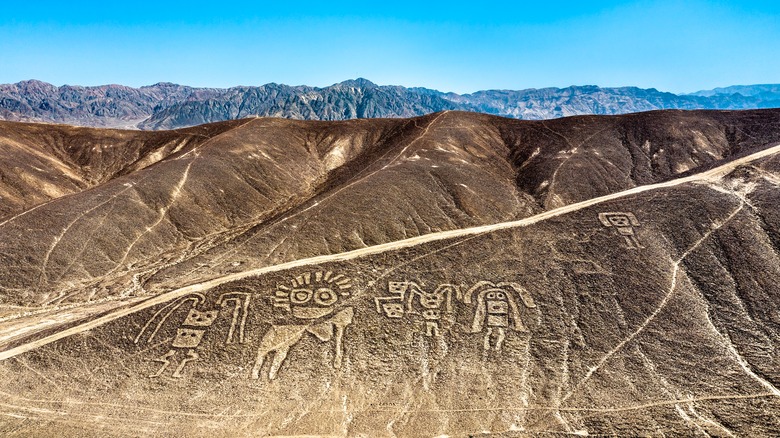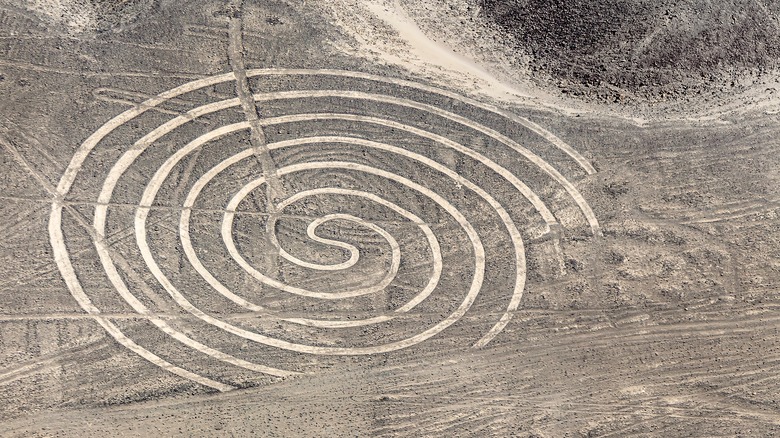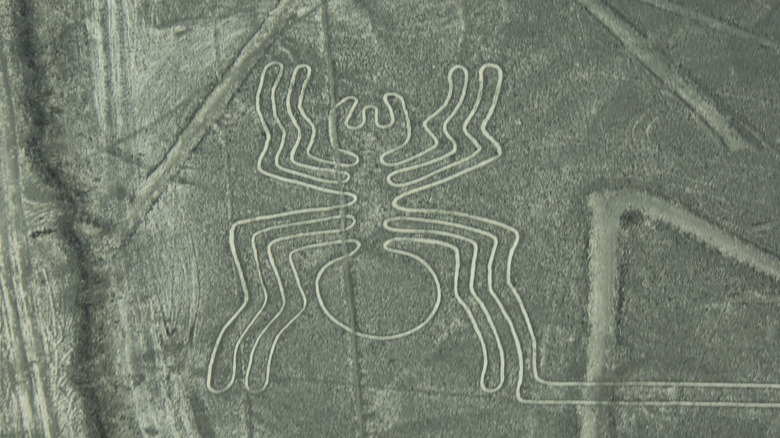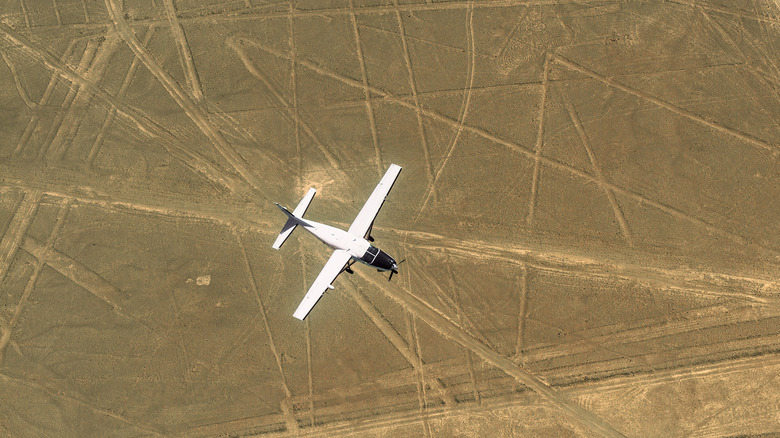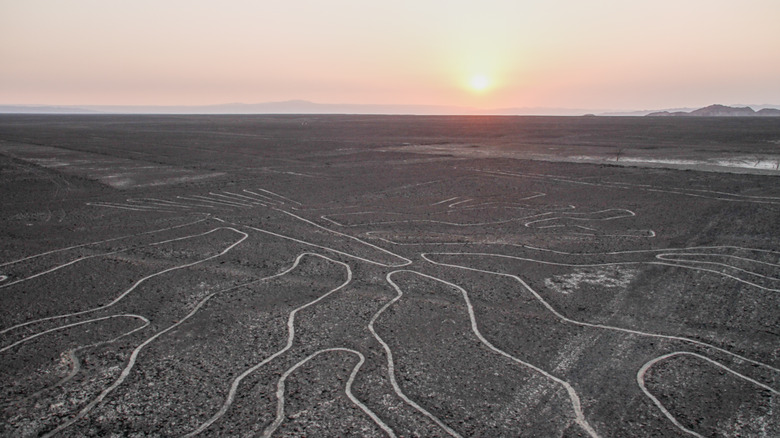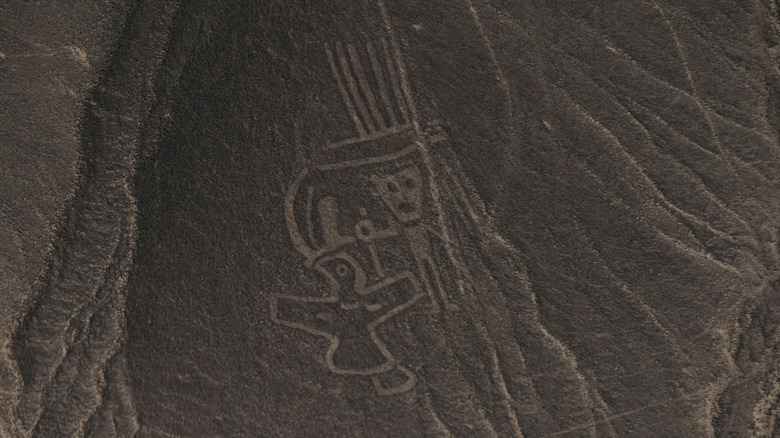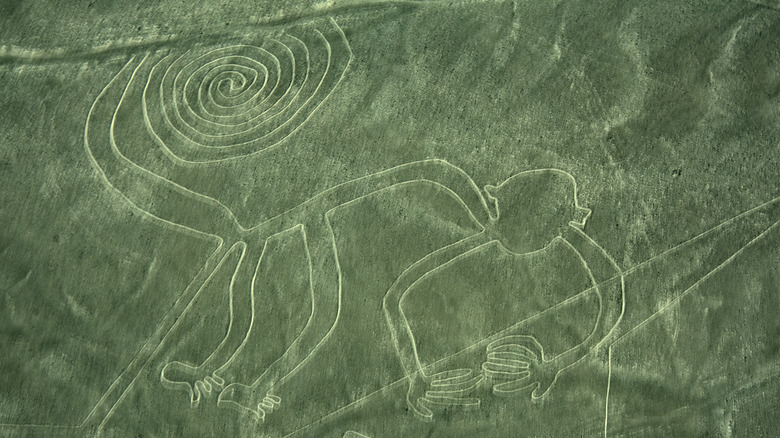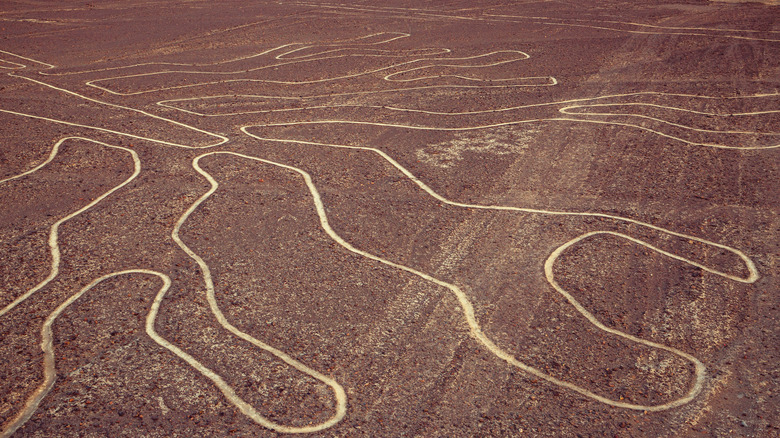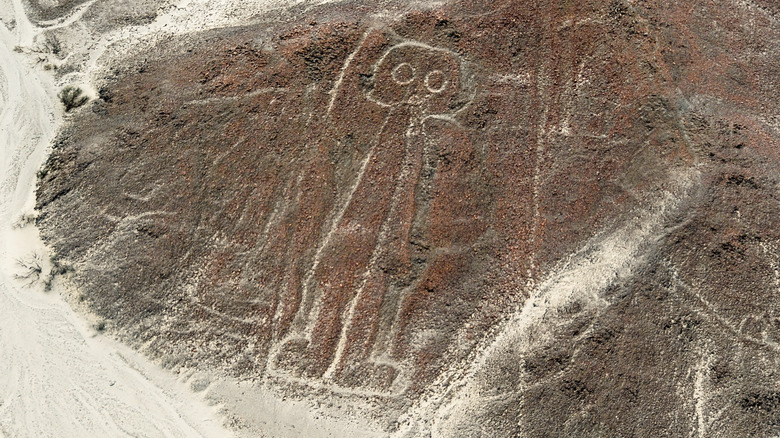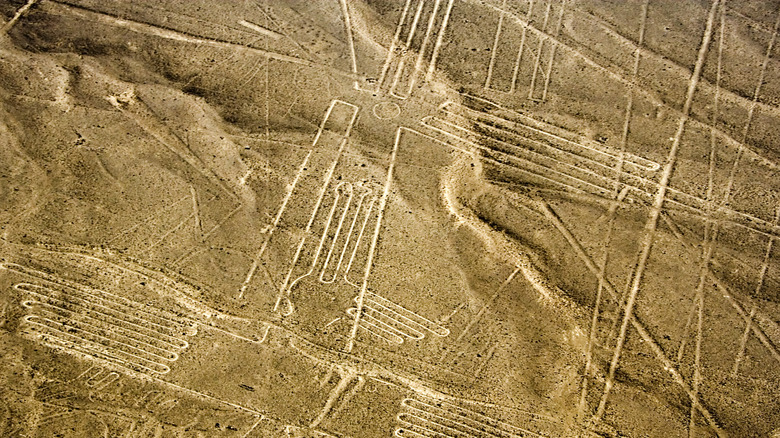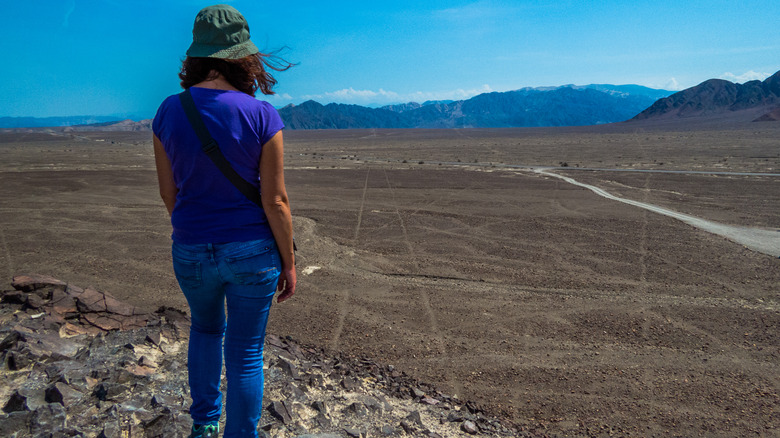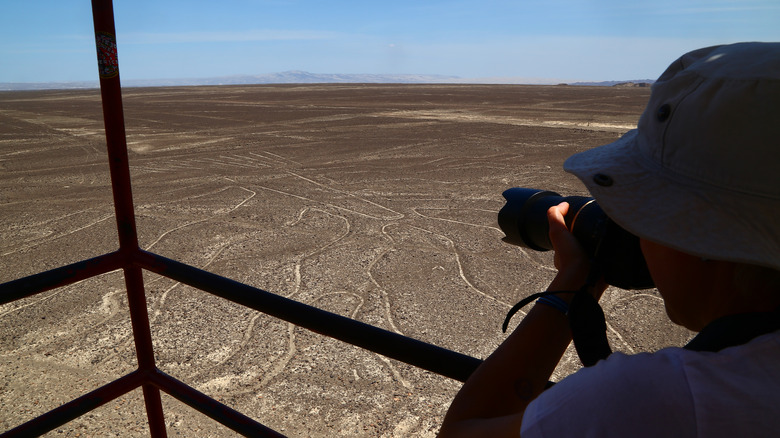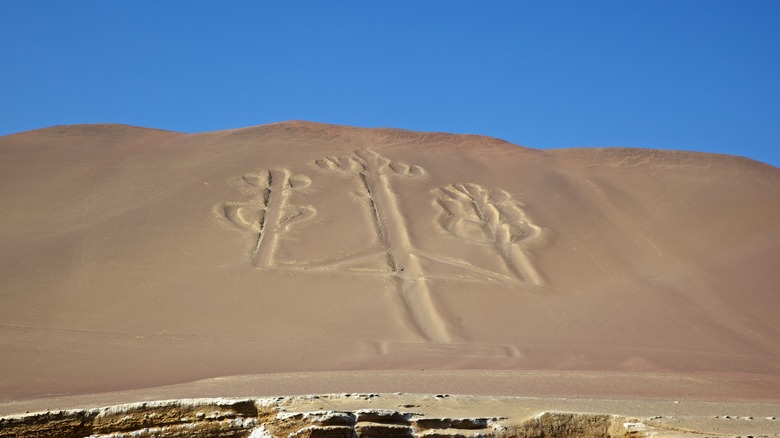The History Of Peru's Nazca Lines
The Nazca Lines are a group of ancient geoglyphs located in the Nazca Desert, also known as the Pampa Colorada (or "colored plain"), in southern Peru. The lines are thought to have been created by the Nazca culture somewhere around 2,000 years ago, though historians have also speculated that a few of the designs were also created by the Paracas tribe even earlier, per Britannica. The lines come in many different forms: Some are straight lines, some are squiggly lines, and some are geometric shapes. Others are images that depict animals and humans. Most of the designs are so large in scope that they can only be seen from the air. In fact, one image spans 1,200 feet total, making it as long as the Empire State Building is tall. The Nazca lines were added to the UNESCO World Heritage List in 1994.
Even to this day, archaeologists aren't entirely sure how many lines and images there are in full. However, there are over 1,000 designs discovered so far, described as "800 straight lines, 300 geometric figures and 70 animal and plant designs" by National Geographic. The animal and plant imagery is surprisingly complex, including images such as a hummingbird, a monkey, and a spider.
A lot of the fascination surrounding the Nazca lines is that scientists and researchers don't know much about their purpose. Several archaeologists have put forward theories, some more plausible than others. However, it seems likely that their true purpose will remain a mystery.
The mystery of the pre-Inca Nazca people
Adding to the mystery of the Nazca lines is the enigma surrounding the Nazca people, who lived before the Inca Empire. According to The British Museum, the Nazca people were an ancient civilization that lived in the dry desert buttressed by the Peruvian coast on the west and the Andes Mountains on the east. The Nazca lived between 200 B.C. and A.D. 650 after breaking off from the dying Paracas tribe to travel to the highlands. One of the biggest and earliest monuments of their power is the ceremonial center of Cahuachi, a collection of burial mounds, plazas, and aqueducts (via World History).
Unfortunately, little is known about the Nazca people's social, political, or religious practices, as they left behind few written records. However, archaeologists have found several artifacts that give clues to important aspects of their culture, including woven goods and pottery. Even more common, however, were instruments. In fact, archaeologists found so many instruments that historians believe that music was an integral part of the Nazca culture. Interestingly, many of the instruments were broken in ways not attributable to the elements, suggesting that the Nazcas would destroy the instruments after performing a ritual to the gods. Historians believed that these rituals were sometimes paired with masks and hallucinogenic substances. The Nazca culture declined and disappeared around the 7th century for reasons that are not fully understood, just like the purpose of their namesake lines.
The incredible way the lines were created
According to History, the process of creating the mysterious geoglyphs involved removing the top layer of rocks, which is comprised of iron-oxide-coated pebbles. Because of the iron, the rocks have a deep rust color. After digging down 12 to 15 inches, the Nazcas would reach the light-colored sand below, which created enough of a contrast to make the designs. Interestingly, there are two different methods that were used to create the glyphs. For most of them, only the rusty pebbles on the outer layers were removed — meaning the images are more like outlines. However, in other lines, the Nazcas removed all the pebbles, creating a solid line. It is not known whether there is a meaning behind the two different techniques.
Though the Nazca lines are known for their size today, historians actually believe that the images started out much smaller, but got bigger and bigger as the decades and centuries progressed, and the Nazcas were able to add to their patterns. These additions showed an incredible knowledge of math and geometry. As noted by World History, famed Nazca researcher Maria Reiche claimed that the Nazcas likely developed their own form of calculus to create the designs with such precision on such a large scale. In addition, scientists observed that they appear to have measured angles, showing their knowledge of geometry as well.
Why the lines are a recent discovery
Because the Nazca desert is such harsh terrain, few civilizations have been able to thrive in the region and it has been largely deserted throughout most of human history. However, in 1926, Peruvian archaeologist Toribio Mejia Xesspe came across the designs, reportedly while going for a stroll along the hills (via Fodor's). It was his archaeologist's eye that helped him make out the patterns since they are difficult — if not impossible — to see at the ground level. Xesspe was the first to catalog the designs, believing they were "sacred pathways" (per World History). However, it was not until the advent of the airplane that researchers were able to see the designs and understand the scope of the lines and geoglyphs.
By the 1930s, planes were flying over the Nazca lines — but, ironically, they were not used for archaeological purposes. Rather, they were commercial airliners, per National Geographic. The pilots and passengers must have had quite an experience looking down and seeing the massive animal and plant designs etched into the earth! From the 1930s to the 1940s onward, researchers were able to use aerial photography to get a better grasp of the lines, marking the catalyst for a new era in research.
The Kosok theory
Paul Kosok was an American historian and archaeologist whose area of expertise was the history of South American irrigation systems and he traveled to the Nazca desert in the 1930s to see if the lines were formations for water. However, he quickly realized they were not.
By chance, Kosok was researching the glyphs on June 21, 1941, which was the day of the summer solstice that year. He saw that the sun's pathway during sunset aligned perfectly with some of the lines, causing him to believe that there was an astrological basis for the designs (via The Nazca Lines). Kosok even went so far as to declare the Nazca lines "the largest astronomy book in the world," per World History. In Kosok's view, the lines were a large encyclopedia that charted the skies. He believed that they were marked in the ground instead of cataloged on paper because the Nazcas were an agrarian society that depended on the land.
The Reiche theory
Maria Reiche was a German mathematician and archaeologist who dedicated much of her life to studying the Nazca Lines in Peru. Reiche arrived in Peru in the 1940s and began studying the lines under Paul Kosok (via World History). Like her mentor, Reiche believed that the lines represented a kind of ancient astronomical calendar. However, she took the theory one step further: Instead of the lines acting as simple markers of celestial events, she believed that they were an active guide the Nazcas followed.
"The Nazca people were able to become a part of the grand astronomical design, observing the movements of heavenly bodies and learning exactly when to begin planting and when to harvest," she said. Similarly, she believed that the lines were also indicative of future lunar and solar eclipses.
Moreover, Reiche added to Kosok's theories by hypothesizing that many of the glyphs were representations of star clusters. For example, she believed that the spider image was a depiction of the Orion constellation. Similarly, she speculated that the monkey drawing was a mark of the Pleiades stars. Reiche's contributions weren't just based on research. She was a steadfast conservationist of the region and was so dedicated to preserving the Nazca geoglyphs that she became known as the "lady of the lines" (via the Los Angeles Times).
The Reinhard theory
Despite the diligence of Paul Kosok and Maria Reiche's work, more recent research has shown that many astrological events do not line up with the Nazca lines, casting doubt on the veracity of the theory (per MDPI). As a result, archaeologists and historians have been forced to develop alternative hypotheses.
Explorer Johan Reinhard developed his own theory by observing the ecosystem of the Nazca desert, which "receives only about 20 minutes of rain per year," he said (via National Geographic). "It seems likely that most of the lines did not point at anything on the geographical or celestial horizon, but rather led to places where rituals were performed to obtain water and fertility of crops," wrote Reinhard in "The Nasca Lines: A New Perspective on their Origin and Meanings" (via National Geographic).
Other archaeologists have agreed, pointing to the geometric shapes of the lines and the geoglyph figures. Trapezoids were a common shape for religious ceremonies. "The trapezoids are big wide spaces where people can come in and out. ... The rituals were likely involved with the ancient need to propitiate or pay a debt to the gods ... probably to plead for water," stated National Geographic grantee Anthony Aveni. In nearby cultures, spiders were a symbol of water; similarly, the monkey — found in the Amazon — represented lush greenery. This theory would also explain why the lines are so large: The Nazcas were so dependent on water that they made a massive sacrifice to please the gods.
The Proulx theory
Like Johan Reinhard, archeologists Donald Proulx, Stephen Mabee, and David Johnston believed that the Nazca lines were related to the scarcity of water in the region. However, they believed that the symbols actually mapped out reservoirs of water located deep underground.
"Ancient inhabitants may have marked the location of their groundwater supply distribution system with geoglyphs because the springs and seeps associated with the faults provided a more reliable and, in some instances, a better-quality water source than the rivers," stated Mabee (via Science Daily). Even though the Nazca desert is incredibly dry, the researchers claimed that due to geological faults, water has accumulated in the desert's valleys, per The Nazca Lines. The team also noted that at least five wells and aquifers in the region "corresponded" with the geoglyphs. "They always seem to go together," said Mabee.
That said, further research into this theory has given only mixed results to support the hypothesis, though this could potentially be due to the shifting geological landscape of the desert across the past several thousand years.
Aliens, hot air balloons, and other outlandish theories
Since the Nazca lines are so impressive, they have also been the subject of outlandish theories to explain their grandiosity. One of the most well-known includes the work of Erich von Däniken, who claimed that aliens had either developed or given advanced technology to the Nazcas to develop the geoglyphs. He described his hypotheses in his 1968 book "Chariots of the Gods," which also claimed that extra-terrestrial beings built the ancient pyramids in Egypt.
Von Däniken bolstered his theory by pointing to one glyph that he said looked like an "astronaut," according to All That's Interesting. However, alternative theories have suggested that the figure, seen above, is simply a giant or fisherman. Though it may be amusing to take the geoglyphs as evidence that aliens already visited Earth, it should be noted that Von Däniken's theories are purely speculative, and no scientific research has backed up his claims (via CTV News).
Less eccentric, though still unlikely, is the theory that the Nazca used hot-air balloons to view their designs from the air. According to Atlas Obscura, researcher Jim Woodmann was able to reconstruct a hot-air balloon using "only materials and techniques that the Nazca would have had available." However, no artifacts, writings, or other concrete evidence has ever been able to suggest that the Nazcas had developed that kind of technology.
What historians actually agree on
While scientists keep floating theories, historians have pointed out that it is also possible that the lines served multiple purposes, and that they were used in different ways by different people or at different times.
But while the debate over the purpose of the Nazca lines continues, there is at least some agreement on how they were used. As noted by The British Museum, the archaeological findings, including ceramics and other spiritual offerings, suggest that they were used in rituals and ceremonies. Archaeologists have even found what appear to be the remains of building foundations, highlighting how central the lines and geoglyphs were to the Nazca people and their living quarters.
In addition, scientific analyses of the soil surrounding the lines and glyphs have shown that the soil is highly compacted. This indicates the ground around the lines was a popular area for people to walk about, with human footsteps cementing the soil down.
The Nazca lines In modern times
Though Peru may be most well known for Machu Picchu, which remains its largest tourist draw, the Nazca lines are making their own mark on the travel industry. Though there are no exact figures on the number of tourists that visit the Nazca Lines each year, The Telegraph estimates that tens of thousands of tourists flock to see the amazing designs each year.
The interest in Nazca, in addition to other attractions like Machu Picchu, has influenced 10% of Peru's workforce and 5% of the nation's GDP to be based in hospitality (via Science Direct). In addition to hotels and tour guides, the aviation industry around Nazca has seen a boom since so many of the geoglyphs can only be seen by air.
Unfortunately, the COVID-19 pandemic had a dire effect on the travel industry, and researchers found that tourism dropped by a staggering 75% due to coronavirus lockdowns. Tourism was further hampered in 2022 by growing civic unrest, including the arrest of Peruvian President Pedro Castillo. This spurred the U.S. State Department to issue a Level 3 "Reconsider Travel" advisory to Peru, per Forbes.
New discoveries are made all the time
Over the past several years, there have been a number of new discoveries and advances in our understanding of the Nazca lines. In fact, on December 20, 2022, researchers announced that they had discovered 168 new ancient Nazca lines in Peru, per The Washington Post. Interestingly, many of these new geoglyphs are not as massive as others. This means that many of them can be viewed in full from the ground.
Another recent development in the study of the Nazca lines has been the use of modern technology to improve our understanding of the site. For example, researchers have used drones and other aerial photography techniques to map the lines in greater detail and detect previously unknown figures and patterns. But it isn't just the photography that has improved: Researchers are now using artificial intelligence to spot patterns that the naked eye might not see (via Science Alert). Scientists believe that these new discoveries are just beginning. In fact, one researcher has claimed that archaeologists have only found around 5% of the full number of geoglyphs, notes The New York Post.
The lines are at risk
Sadly, the Nazca lines have been damaged by various actions over the years. Some of the lines have been harmed by natural forces such as wind and rain erosion, but others have been damaged by human activity.
One of the most high-profile instances of damage to the Nazca lines occurred in 2014 when a truck driver named Jainer Flores Vigo drove over several of the lines during a car chase in which he attempted to evade police. Vigo was later arrested and faced heavy fines for damaging the lines, per Peru21. Similarly, Greenpeace came under fire for staging a demonstration right next to the hummingbird geoglyph. Their protest left footprints and other markings close to the design, which is the only completely untouched example of the Nazca lines. As noted by The Guardian, Greenpeace later apologized for the damage and for causing "moral offense to the Peruvian people."
The Nazca lines have also been accidentally defaced by tourists who have walked on them or disturbed them in other ways. In response to such incidents, Peruvian authorities have implemented more strident measures to protect the lines and limit access to them in order to protect the incredible setting for posterity.
